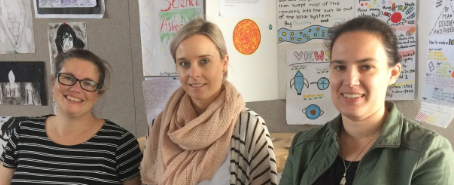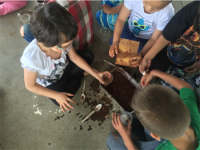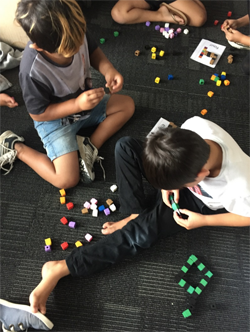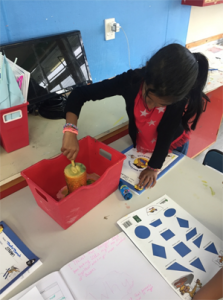Heather Kluit, junior school leader from Flanshaw Road School, has been leading a Teacher Led Innovation Fund (TLIF) project across a cluster of seven schools for the past two years.
In the last six months she has been supported by Anna Watkin, junior school leader, and Nicola Smith, junior school teacher, from Massey Primary.
In this snapshot, Heather, Nicola, and Anna share their learning through supporting collaborative STEAM inquiries with their junior school colleagues, across their schools and other schools in the cluster.
How did they get started?
The WAPA 2020 cluster principals met in 2015 to look at how they could refocus on building students’ curiosity and excitement in learning across the curriculum. Heather, Nicola, and Anna were junior school teachers who had a real passion for engaging learners in real life hands-on experiences, so the idea of STEAM projects really appealed to them. Heather was asked if she could lead the project with another teacher from Henderson North School, Chantelle Rich. When Chantelle left for a promotion, Nicola took her place with support from her junior school leader, Anna.
How does STEAM work in the junior school?
Massey Primary
“I take year level groups (years 1–3) out three times a week for STEAM. My big focus is on developing 21st century capabilities – collaboration, critical thinking, problem solving, creativity, communication and citizenship, adapted from the New Pedagogies for Deeper Learning competencies. In my classroom we make authentic, meaningful real world connections. For example, someone had thrown a lunchbox on the classroom roof so we used that to problem solve as to how to get it down. Students made a prototype of a model that could lift people up and get the lunchbox down, which was able to hold weight. It’s not all flash digital devices. We used string, paper cups, straws, and tape.”
Nicola
“Almost all teachers are using STEAM as a writing experience and also integrate STEAM into inquiry topics, for example, hands-on activities based on big books – all helping to support literacy. STEAM knowledge is being built with a focus on problem solving and collaboration.
Teachers bring in content knowledge and then provide a challenge-based STEAM activity that requires use of that content knowledge. STEAM is becoming integrated in everything we do, including maths. Maths is however, more stand alone.”
Anna
Flanshaw Road
“STEAM is integrated as much as possible in our reading, writing, maths, and inquiry. It could be an independent activity that is a follow-up to a reader, an oral language experience, writing a recount or giving instructions, descriptive writing, or solving real-life maths problems. We focus on thought-provoking inquiry questions.
With teachers who have been exploring STEAM for a while it is expected to be happening at least once a day if possible. For those who are new to STEAM, it is either still stand alone or integrated into inquiry and strand maths.
With resources it’s all about everyday objects or classroom materials. It’s not about flash expensive digital tools. We quite often use pipe cleaners, paper, Sellotape, string, straws, lego, and popsicle sticks.”
Heather
Integration of learning areas
In STEAM inquiries, teachers and students can make use of the natural connections between learning areas. Teachers involved in the WAPA 2020 cluster support their students to transfer knowledge and skills from a range of learning areas to their STEAM projects. Learning is also linked to the NZC values and key competencies.
Return to top
What are the highlights of STEAM?
- Seeing the transference of the content knowledge into STEAM activities.
- Those "ah ha" moments when kids see the connection between what they are doing and the content knowledge.
- Watching teachers have their own STEAM "ah ha" moments.
- Seeing students transfer new learning to other contexts.
- The kids are so excited. It’s fun and engaging. They ask to have STEAM classes. There are absolutely no students who don’t want to be involved in STEAM. Kids love having hands-on, thought provoking activities where they are practicing their problem solving skills.
- Building experts (students) to support the very little ones and then students can do the planning instead of teachers.
- The activities that kids are setting are all hands-on and more inclusive.
- The kids lead. The teacher begins a unit and then all students take part in the planning of STEAM activities. STEAM is more student driven. The kids choose areas they want to explore and research.
Effective pedagogy
The teaching approaches used in the STEAM inquiries are known to promote student learning. Students have the opportunity to assimilate new learning, relate it to what they already know, adapt it for their own purposes, and translate thought into action. They are involved directly in decisions relating to their own learning, they can make connections to prior knowledge and experiences, and they regularly engage in shared activities and conversations.
What are the challenges?
“In our space it’s timetabling. With our large MLE we have different teachers timetabled to take other subjects. Otherwise I can’t think of any challenges.”
Anna
“Developing consistency about what STEAM is, as our teachers are all at different stages of our STEAM journey.”
Nicola
“Integrating and deepening the work with everything else that is going on at school. I would like more time to go into other classrooms.”
Heather
As STEAM leaders, how do you encourage other teachers to be involved in STEAM?
Nicola and Anna worked together with students first then they each worked with another teacher and that teacher would then buddy with another teacher so all teachers had support with STEAM in the junior school. This year they’ve brought in teachers from other syndicates to be part of the STEAM team. They are growing capability and doing more with Nicola and Anna’s support. Teachers understand that STEAM needs to involve the problem solving aspect. Currently Nicola is modelling Makey Makeys and Anna is supporting teachers with their STEAM planning.
Heather did something similar at Flanshaw Road, first consolidating her own ideas, then identifying teachers who are ready to get on board. She spent some time getting buy-in from staff. A successful strategy was using students to show other students at a whole school assembly. The students showcased their STEAM activities and got teachers to participate. Heather runs two STEAM staff meetings a term based on the school’s inquiry topics and offers help with lesson planning. Team meetings also have a hands on STEAM activity. It is an expectation that team leaders have this as part of their planning.
Nicola and Anna have provided step-by-step lesson plans for new teachers and relief teachers. The STEAM teachers in the WAPA 2020 cluster meet each term to share STEAM inquiries, strategies, and resources, and Nicola and Anna share these with teachers at Massey Primary staff workshops.
Return to top
How successful has this been?
“A lot of teachers have more hands-on activities that allow for creativity and problem-solving. A big one I’ve noticed is teachers stepping back on their locus of control. They are becoming more aware of how learning can interlink in other learning areas, so learning areas are not in silos. Teachers can make those connections even more explicit.”
Heather
“Teachers are moving into other areas through STEAM, for example, environmental studies. The more STEAM activities they do the more confident they are becoming. They see kids engaged and notice the benefits, for example, seeing ESOL kids having success and students generally being more inclusive.”
Nicola and Anna
What have you learned from leading the STEAM project across a cluster?
“I didn’t have any facilitation experience so that was a huge learning curve for me, particularly at the beginning when all 15 teachers met for PLD and to share their inquiries. For example, trying to figure out what people need, getting feedback, and coping with others’ opinions. Collecting all the data from seven schools and supporting teachers with that was interesting as we were all working off different platforms.”
Heather
“We didn’t know what STEAM was at the beginning but the PLD and sharing sessions with other teachers gave us the confidence to use STEAM activities with our students and staff at Massey. This made us hungry for more so we directed our own in-school PLD after seeing the benefits to raising achievement. Becoming a project lead teacher has lifted our capabilities even higher. This has only happened because of the STEAM cluster. Now we are going beyond the network and leading this mahi in our kura and Kahui Ako.”
Anna & Nicola
Advice for others?
Have the freedom to experiment
It’s important for teachers to know they have the support and are trusted to try new things, that it’s OK if their STEAM inquiries don’t go as well as expected. The principal needs to walk the STEAM talk, understand and promote the pedagogies for effective STEAM projects, offer support, and empower teachers to take risks.
Alignment
STEAM needs to align with everything else the school is doing so it’s not seen as an extra. It should align with the school vision and values and be embedded in the school culture.
Teacher mindset
The teachers need to be problem solvers themselves to embed STEAM. Teachers have to model the problem solving and questioning. They have to be open to new learning.
Integration
STEAM needs to be integrated across all learning areas. This can accelerate the positive impact on student engagement across a range of learning areas.
Assessment
It is necessary to revisit assessment methods. It’s not just about the content knowledge but the capabilities as well. The cluster used SOLO for assessment, for teachers and students. SOLO helps students set goals and talk about their learning.
Sharing
Ensure there are opportunities for teachers to share their STEAM inquiries and reflections. Share effective strategies in STEAM, for example, through modelling questioning and creating curiosity in students.
Universal Design for Learning (UDL)
UDL needs to be embedded in the school culture. UDL ensures teachers know their students and whānau and can gear their STEAM projects towards student interest and ultimately increase student agency.
Access experts
Experts can challenge teachers to think differently. New learning can take you out of your comfort zone but help you to break down the barriers to learning and change how you think about teaching.
Resources
Resources for STEAM do not need to be high-tech. Everyday household equipment is generally more useful and multi-faceted at all levels. Use the internet for ideas, particularly YouTube. Picture books can be used as motivation. Robots and MaKey MaKey type resources (Little Bits) are fun.
Give it time
Time is crucial; from the introduction of STEAM, to students beginning to build their knowledge and skills, to applying their knowledge to other contexts.
Have you seen?
Teacher-led Innovation Fund
TLIF supports teams of qualified teachers from early learning services, ngā kōhanga reo, schools and kura to collaboratively develop innovative practices that improve learning outcomes.
- Tags:
- effective pedagogy
- integrated curriculum
- learning areas
- primary
Return to top




